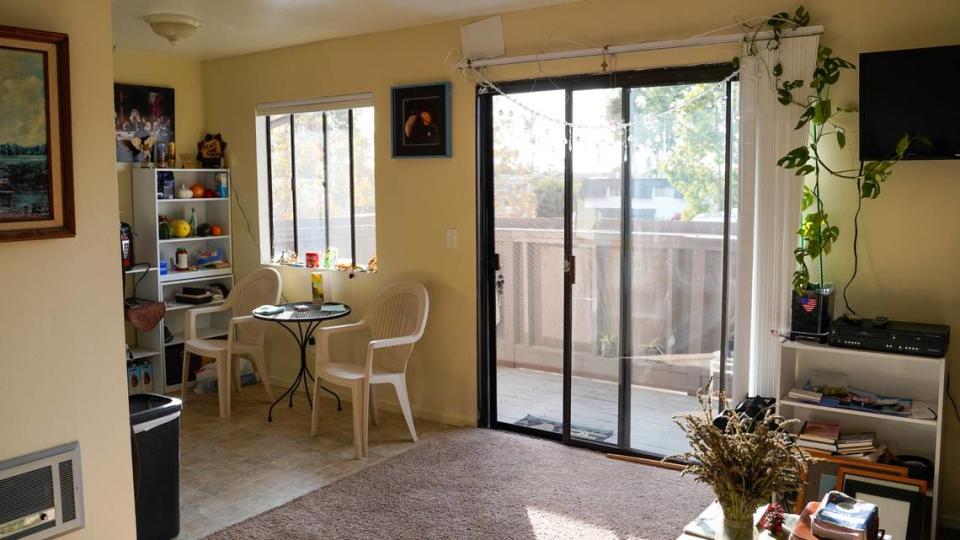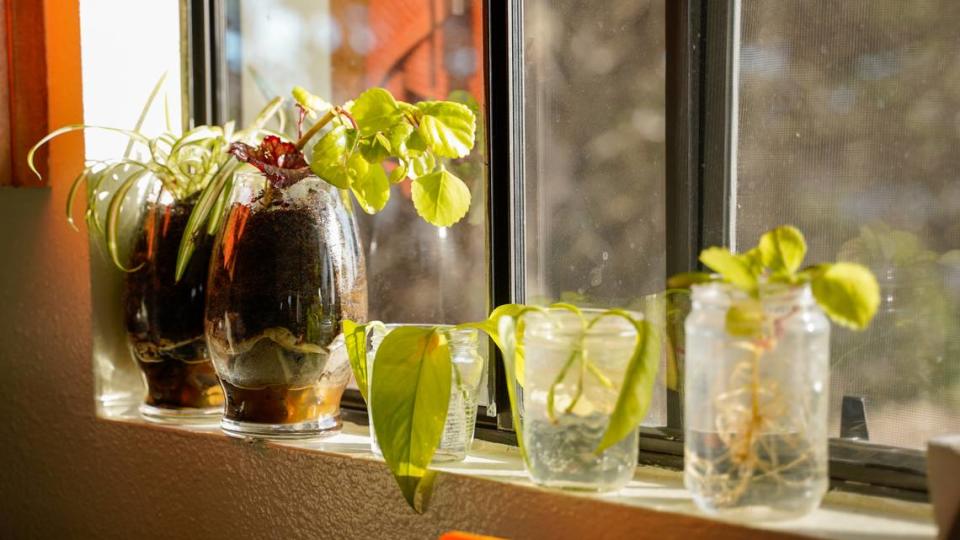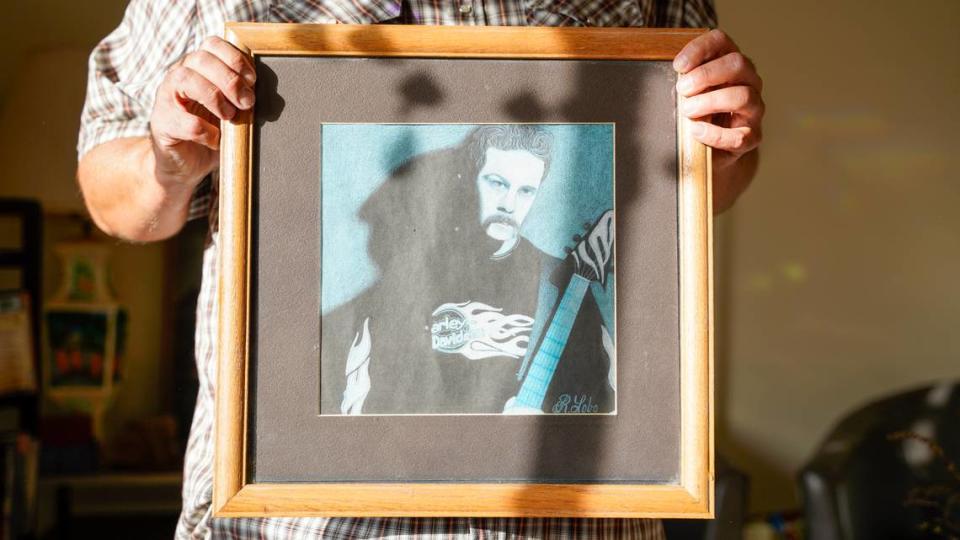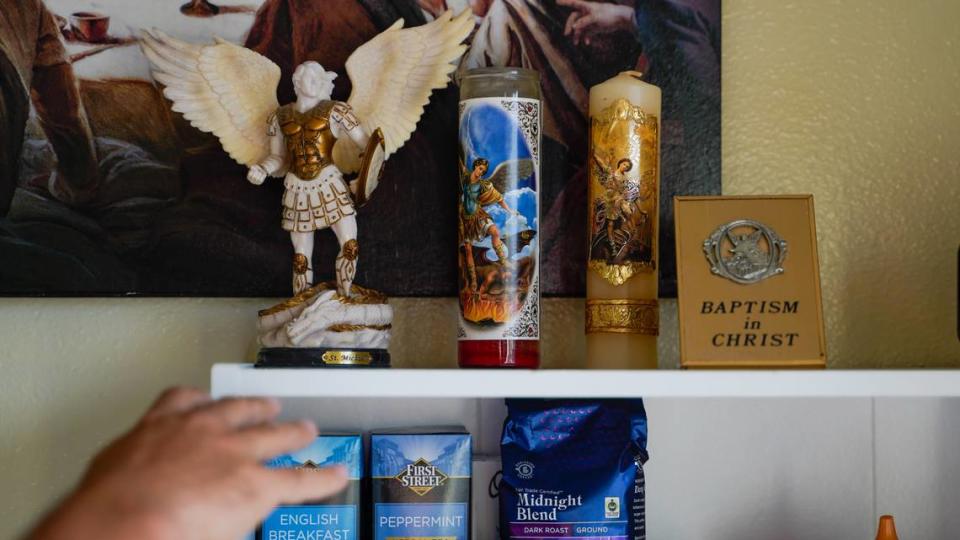What’s it like to go from homeless to housed in SLO County? ‘Every step, I got more freedom’
When Luke kicked out the window of a police car in 2019, it led to what he described as a “wake-up call.”
He had lost his housing after his partner at the time moved out, leaving him unable to meet the rent on his own, and was then living in Santa Margarita Community Park.
“That was the first thing that got me into (Alcoholics Anonymous),” Luke said. “When you kick out a cop car while you’re drunk in public, they take that kind of seriously.”
By the time Luke lost his housing in 2019, he had already accumulated around 20 drunk in public charges, and doesn’t remember much from the years of heavy drinking.
Since that incident, Luke — a San Luis Obispo County resident who asked not to be identified by his real name due to privacy concerns — has worked to turn his life around, completing alcohol abuse counseling, getting a new job and, most importantly, completing his journey through San Luis Obispo County’s housing pipeline, from homelessness to independent living.
Luke said that journey was never easy, and is full of instances of people and organizations being willing to give him the benefit of the doubt.
“My story is about people giving me a second chances, third chances,” Luke said.

Pandemic, alcohol addiction made shelter scarce while homeless
Luke has lived in San Luis Obispo County for nearly 20 years, initially moving to the area from San Bernardino to attend Cal Poly.
He graduated in 2007 with a degree in agriculture, but didn’t find a job in his field. He instead opted for a series of short-term jobs in schools, churches, hotels, an employment agency, groundskeeping and custodial work.
For several years, he said, this approach worked, and kept his life relatively stable.
All the while, though, he started drinking more, and despite two years of sobriety between 2013 and 2015, the problem continued to grow, he said.
Luke said becoming homeless just before the start of the COVID-19 pandemic was one of the most stressful, challenging times of his life, during which he fell deeper into alcoholism.
Though life was quiet during lockdown — when San Luis Obispo’s streets were emptied of their usual crowds save for the city’s homeless population — it wasn’t easy, as there were no opportunities to panhandle, and formerly accessible restrooms suddenly locked their doors.
“If I wanted to be in San Luis Obispo, there was a broken water fountain at Emerson Park, but there was also a porta-potty,” Luke said. “There was a good drinking fountain at Mitchell Park, so you had to choose: If you’re going to sleep in one or the other, you’re going to have bathroom access or drinking fountain access. They didn’t have both.”
In 2020, he stayed at the El Camino Homeless Organization’s Atascadero shelter and 40 Prado Homeless Services Center, but issues related to his addiction forced both organizations to kick him out.
“I had some struggles my first time (at ECHO) — self inflicted — and had to be let go from that program, but they were kind enough to give me another chance to be able to once again be a resident of ECHO,” Luke said. “I’m still probably 86’ed from Prado.”
Being 86’ed from a shelter means being asked to leave and not return.
Luke returned to ECHO’s Atascadero shelter in December 2020, where he began to work with a case manager as part of the shelter’s 90-day program, which uses intensive case management and a reserved bed to help move homeless clients toward housing.
As it happened, 90 days was almost exactly what he needed.

What is life in a permanent supportive housing project like?
While staying at the Atascadero shelter, Luke’s case manager “did a lot of footwork” to get him approved for the Housing Authority of San Luis Obispo County’s Homekey complex in Paso Robles, which started admitting its first residents in early 2021.
The complex provides permanent supportive housing units for homeless individuals and families by using project-based vouchers that limit rent to 30% of the household’s monthly income.
Luke was among the first batch of residents to move into the complex in March 2021.
Finding and holding employment — which Luke said was nearly impossible while homeless during the pandemic — suddenly became an option again, along with working on his sobriety and establishing a sense of security.
“I was actually giving ECHO cash money to hold onto for me,” he said, “so that when this (housing opportunity) opened, I actually had cash saying, ‘Yeah, look, Luke has a job, Luke has money, Luke can pay rent.’”
That’s not to say living at the Homekey complex was easy, he said.
Luke said during his stay, he was required to change rooms multiple times and wasn’t allowed to move his own belongings, which caused damage to several of his possessions.
At the time, the complex was still undergoing intensive construction as more rooms were refit into studio apartments and shelter spaces, causing disruptions and internet outages, he said.
Hours for AA meetings — Luke’s preferred way of dealing with his alcohol abuse disorder — were also inflexible, and rarely aligned with his work schedule, which challenged his sobriety, he said.
Luke said he observed drug and alcohol use in and around the complex at times, which often triggered his sobriety.
“That’s complaining about other people who have addiction issues, and I thank God that God showed me grace, and I’m not struggling with that right now,” Luke said. “I’m not different than those people, but it was hard for those people who wanted to be sober.”
Luke said he frequently butted heads with the complex’s management, often over the scheduling of meetings, delays in distributing promised housing choice vouchers and lapses in communication.
By the end of his stay, it was clear that while a roof over his head that he could return to each day was a significant improvement from time on the streets and in shelters, living at the Homekey complex was never going to be a good permanent solution for his housing needs, Luke said.
“For some people, it’s perfect — maybe they don’t aspire to get a job, a career or retirement savings — maybe they’re at a point in their life where they just need a roof over their head and security,” Luke said. “For me, it was always going to be a stepping stone. I wasn’t going to stagnate there and die.”

Struggle with sobriety delays permanent housing
Luke ultimately stayed at the Homekey complex for more than two years as he looked toward his next steps.
In July 2022, he received a housing choice voucher through HASLO, which limits his rent to 30% of his income so long as his landlord accepts the voucher.
However, Luke would have to wait more than a year to put the voucher to use. Just a month after receiving the voucher, he “crashed and burned,” relapsing while visiting the California Mid-State Fair.
Luke said he spent the next 10 days in a “helpless condition,” falling deeper into alcohol abuse, until a close friend took him in and nursed him back to health — help Luke said saved his life.
“Credit for the people at Paso Homekey — they knew I was struggling, and they recognized that recovery is a process,” Luke said. “That was one of the things that I appreciated the most — they didn’t kick me out when I was struggling.”
When he was sober and mentally competent again, Luke said he started looking for a place to use his voucher while trying to prevent another relapse from happening, which meant not making major changes to his housing situation for the next year.
Luke said that strategy worked; since his last relapse in the summer of 2022, he has maintained 15 months of sobriety.

Where is Luke now?
Eventually, Luke got the chance to use his housing choice voucher, settling into an apartment in Arroyo Grande in August this year.
Luke said even with his new job, where he makes minimum wage, he would not have been able to afford his rent without the voucher, which requires him to pay 30% of his income, or $796, as rent each month.
Since being matched to a place of his own by a HASLO case worker, Luke said he’s begun to recover the daily skills and routines he lost while homeless.
With a full kitchen at his disposal and the freedom to pick his meals and ingredients, Luke said he’s lost around 20 pounds in the three months he’s lived in his apartment — not because of malnutrition, but because the quality and nutritional content of his food is better than he could have hoped for at a shelter.
The apartment gets plenty of light, and has a small balcony, allowing Luke to finally grow plants in earnest again. Some have been with him since he started living at the Homekey complex.
A devout Christian, Luke has decorated his apartment with reminders of his faith, including depictions of Saint Michael, the saint associated with protection from evil and temptation.

He said he credits his faith for keeping him resilient against his worst impulses, and for connecting him to organizations such as AA, ECHO and the National Alliance on Mental Illness, through which he’s given talks to law enforcement officers as part of their drug and alcohol training.
“God did for me what I couldn’t do for myself,” Luke said. “Otherwise, I’d still be drinking, because I’m an alcoholic; left to my best ideas, I drink. God took away that desire, and part of it was people showing me that I was worth more than just dying out on the streets.”
As he’s settled in, he’s begun to add items and decorations he’s accumulated in his post-homelessness life, such as a flask engraved with the words “Not today, Satan,” made by the friend who saved his life during his last relapse.
Every time he moved up to the next level of housing, the amount of choice he had in his daily life grew — and so did the amount of gratitude he felt, Luke said.
“With every step, I got more freedom,” he said.

